 25 August 2016
2016- n° 217In August 2016, the economic climate is stable in the building construction industry Monthly survey of building - August 2016
25 August 2016
2016- n° 217In August 2016, the economic climate is stable in the building construction industry Monthly survey of building - August 2016
According to the business managers surveyed in August 2016, the business climate is stable in the building construction industry. The composite indicator has been at the same level (95) since April. It stays below its long-term average (100).
According to the business managers surveyed in August 2016, the business climate is stable in the building construction industry. The composite indicator has been at the same level (95) since April. It stays below its long-term average (100).
graphiqueClimate – Business climate composite indicator
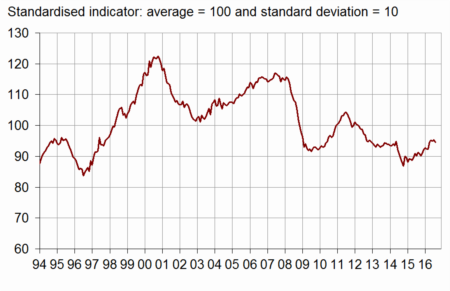
graphiqueTurningPoint – Turning-point indicator
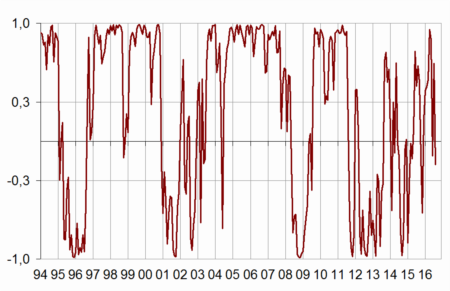
- Note: close to 1 (respectively –1), it indicates a favourable climate (respectively unfavourable). Between +0,3 and –0,3: uncertainty area.
The turning point indicator has gone into the uncertainty zone.
Revisions The business climate in July 2016 has been revised downward by one point since its first estimate, because of late businesses' answers that have been taken into account.
Business managers are less optimistic about their activity for the next few months
In August 2016, more business managers than in July forecast a fall in their activity for the next few months. The corresponding balance has slipped back to at its long-term average. The balance of opinion on past activity is virtually stable at a level below its long-term average.
graphiqueActivity – Activity tendency in building construction
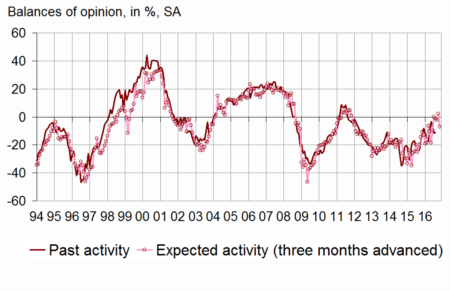
tableauTableau1 – Building industry economic outlook
| Mean* | May 16 | June 16 | July 16 | Aug. 16 | |
|---|---|---|---|---|---|
| Composite indicator | 100 | 95 | 95 | 95 | 95 |
| Past activity | –4 | –3 | –6 | –12 | –11 |
| Expected activity | –7 | –1 | –2 | 2 | –7 |
| Gen. business outlook | –19 | –6 | |||
| Past employment | –5 | –22 | –22 | –21 | –23 |
| Expected employment | –5 | –14 | –16 | –14 | –16 |
| Opinion on order books | –24 | –46 | –45 | –45 | –43 |
| Order books (in month) | 5,4 | 6,6 | 6,4 | 6,9 | 6,9 |
| Production capacity utilisation rate | 88,5 | 85,5 | 85,8 | 86,5 | 87,0 |
| Obstacles to production increase (in %) | 32 | 21 | 22 | 23 | 25 |
| - Because of workforce shortage (in %) | 14,1 | 2,7 | 3,3 | 3,9 | 4,7 |
| Recruiting problems (in %) | 57 | 45 | |||
| Expected prices | –15 | –25 | –23 | –23 | –22 |
| Cash-flow position | –10 | –9 | |||
| Repayment period | 29 | 31 |
- * Mean since September 1993.
- Source: INSEE, French business survey in the building industry
Business managers remain pessimistic about employment prospects
In August 2016, slightly more business managers than in July point out a fall in their staff size in the recent period and for the next three months. The corresponding balances of opinion stand well below their long-term average.
graphiqueWorkforce – Workforce size tendency in building construction
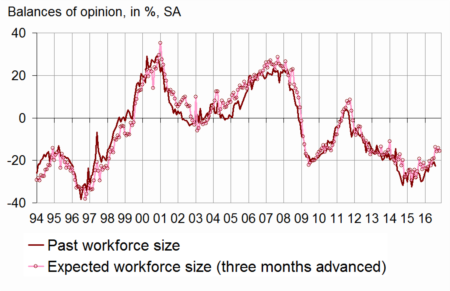
Order books stay judged far lower than normal
Business managers continue to deem their order books very low: the corresponding balance has recovered slightly since May 2016 but stays far below its long-term average. With their staff size, business managers consider that their order books provide 6.9 months of work, a level stable compared to the last month and above its long term average (5.4 months).
graphiqueOrderBooks – Order books
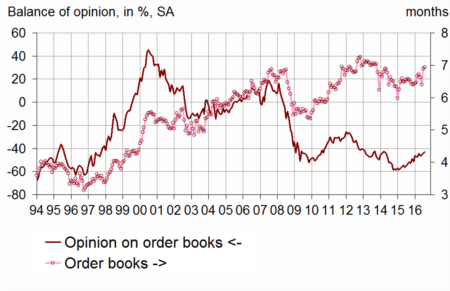
Production capacity is a little less underused
Since 2008, the production capacity utilisation rate has been inferior to its long-term average (88.5%). However, it has gradually increased since early 2015. In August 2016, it has risen slightly again at 87.0%, around three points above its lowest level in February 2015. One business manager out of four has reported difficulties in increasing output, against one out of three in average since 1993. This rate has increased by six points since October 2015 and has reached in August its highest level since January 2014.
graphiquePcur – Production capacity utilisation rate
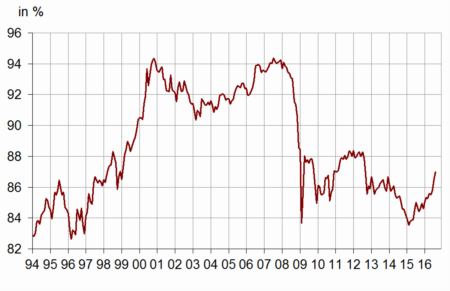
Prices are still expected to fall
In August 2016, almost as many business managers as in July announce that they are going to reduce their prices during the next three months. The corresponding balance remains substantially below its long-term average.
Documentation
Methodology (2016) (pdf,170 Ko)



